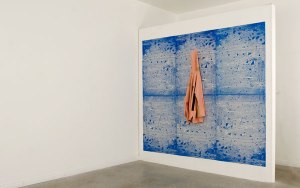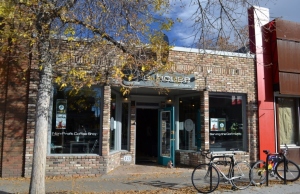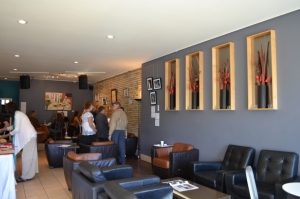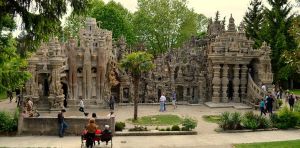Tomorrow, the trustees of the Tate Britain will announce the winner of the 2014 Turner Prize. One of the four nominees is Canadian-born printmaker – Ciara Phillips.
Normally, an event that is taking place half-way around the world would be a non-event for this blog. However, I believe it is timely for discussion in Calgary, regardless of whether she wins or not.
For those who do not know, I am a former gallerist that operated a member gallery of the Art Dealers Association of Canada which dealt primarily with printmaking and prints. As a result, I have a very deep appreciation and understanding of the printmaking process, even though I am not a printmaker myself. For whatever reason, the printmaking medium, gets very little respect and appreciation in the city. It has been that way for a very long time, which is surprising given the strong printmaking tradition in the city and that there is an amazing collection of block prints (in particular) which is housed at the Glenbow. This all is quite unfortunate situation that I can only hope will change in time.
Secretly, (well maybe not so secretly anymore) I am pulling for her to win. I do see that she probably is somewhat of a longshot, although definitely in the running. In the UK, there is an interesting phenomenon in that people make wagers, and bookies make books on the outcomes of major cultural prizes, along with the usual horse races, football games and boxing matches. The Turner Prize is no exception.
When I checked a few minutes ago the average odds at the time of retrieval, the consensus order of payout (or from most-likely to least-likely) as determined by a survey of various bookies, is as follows:
- Duncan Campbell is the favourite, a win would payout £7 for every £4 bet (1.75x);
- A Ciara Phillips win would payout £11 for every £4 bet (2.75x);
- A James Richards win would payout £3 for every £1 bet (3.0x);
- A Tris Vonna-Mitchell win would payout £7 for every £2 bet (3.5x).
If only people cared that much on the visual arts in this city that they would bet on and for artists. If we did, we would probably have a civic art gallery and actually support the visual arts and its artists – but I digress.
Getting back to business.
Ciara Phillips was nominated for an exhibition that she held during 2013 at The Showroom, London that ended one year ago today (November 30). The exhibition was described as follows, and I will quote at length (there is substantially more, if you feel so inclined) to help put this posting into context for those in Calgary who may not click on the hotlink and to understand the timeliness. Here is what The Showroom had to say about this exhibition:
Workshop (2010–ongoing) is a new installation made up of multiple screenprints on newsprint and large-scale works on cotton. This new work sets an attitude for a two-month temporary print studio that will take place in the gallery over the course of the exhibition.
Throughout October and November (2013) Phillips will be collaborating with invited artists, designers, and local women’s groups (many of whom have ongoing relationships with The Showroom) to produce new screenprints. Guests will bring their different knowledge and experiences of working collectively to the Workshop, whose structure is open for development as the project progresses. These new collaborations will initiate conversations and actions that aren’t contained within specific disciplines of art, community action, design or activism. By making prints in these new collaborative groupings, Phillips will explore the potential of ‘making together’ as a way of negotiating ideas and generating discussions around experimental and wider uses of print.
We know that Ciara Phillips showed in Calgary previously and I was fortunate enough to have seen the group show which she was included in, during the summer of 2013 at the short-lived Haight Gallery (which has subsequently closed, probably right after the group show ended). The photo above was from that show, and the same exhibition was also shown in January 2014 at Edmonton’s Latitude 53 – an artist run centre.
Now to get to the core of the matter.
Why is this relevant to Calgary?
As seen above, we know that Ciara Phillips has shown in Calgary. We also know that there is a significant artistic exchange that occurs between Glasgow (where she currently lives) and Calgary. I could easily rattle off a good sampling of names without too much difficulty.
We also have seen a significant increase in collaboration in the city’s institutional culture. Here are some examples:
- Earlier this year it was announced that Calgary will host the MassMOCA produced Oh, Canada show which will open in January 2015. This will be a collaborative exhibition spread between Glenbow, Esker, Nickle, and the Illingworth Kerr galleries.
- Not so long ago Contemporary Calgary co-hosted a portion of the Made in Calgary: The 1990s show and the Nickle currently is co-hosting the Glenbow’s Made in Calgary: The 2000s show.
- We can also reference the initial Nuit Blanche show in 2012 where they informally collaborated with MOCA Calgary (now Contemporary Calgary).
- Then there was the partnership between the Calgary Stampede and MOCA Calgary for a 1912/2012 focused show during the summer of 2012.
- We can also talk about the long-standing (maybe 15-20 year long) relationship between the Centre for Performing Arts and mostly artist run centres in the six +15 window spaces which has recently been expanded to also include the Alberta Craft Council, Tiny Gallery and the University of Calgary. There may be more in the works as I see construction happening in the same general area.
Even other organizations outside of the visual arts like the Calgary Philharmonic Orchestra is getting in on the act with a performance which involved students in the MADT program at the Alberta College of Art and Design in their performance last night of Olivier Messiaen’s Turangalila.
Beakerhead is yet another fine example where it was set up to explore where collaboration can exist between the engineering and science communities with the visual arts.
I know that I have only touched upon a few partnerships, but as seen above it is an increasingly important part of the cultural landscape that is developing in the city for various reasons. It is probably a good thing.
In a recent interview in the Ottawa Citizen where she is quoted as saying, “I think it (the Turner Prize) has drawn a lot more attention to my work, and there have been some really nice outcomes of that, especially invitations to make future exhibitions in Sweden and Canada.” This was also repeated a few days later (earlier this week) in a recent interview with Canadian Art magazine.
Alberta Printmakers Society is one such organization that could potentially host this show in their new facility. Although, having said that, I would think the gallery space might be a bit on the small side.
From a personal observation, A/P has become much more active recently and has shown a willingness to program potentially controversial exhibitions such as the recent Joscelyn Gardner show which ended yesterday, entitled bringing down the flowers. . . I attended the opening of Gardner’s show this past October 24th and had a good discussion with her while I was there. It was my intention to write something about it, but due to other more pressing circumstances, I was unable to find the time to do so. It was a very strong show and it dealt with issues that should have a higher visibility and dialogue in this country. Certainly, more so than what is currently the case. I may still, even though it is too late to see the show at the Artist Proof Gallery.
Given this as background, and understand that this is complete and unsubstantiated speculation as an outsider, does that mean we may potentially see Caira Phillip’s Workshop (2010 – ongoing) make an appearance in Calgary in the near future?
Maybe there is a partnership with A/P and another organization such as the Esker, Illingworth Kerr Gallery, the Banff Centre or potentially Contemporary Calgary or the Glenbow in the works?
Let’s hope so.
* * *
December 1, 2014 edit
I checked the news to find out who won the Turner Prize this year. The winner was Duncan Campbell. It is not surprising given that the film he was nominated for was previously shown at the most recent Venice Biennale.
It doesn’t change anything about collaboration, which was the primary focus of this posting. Of course that possibility of a Canadian show for Ciara Phillips is still out there and I think that it would be awesome if it took place in Calgary.




